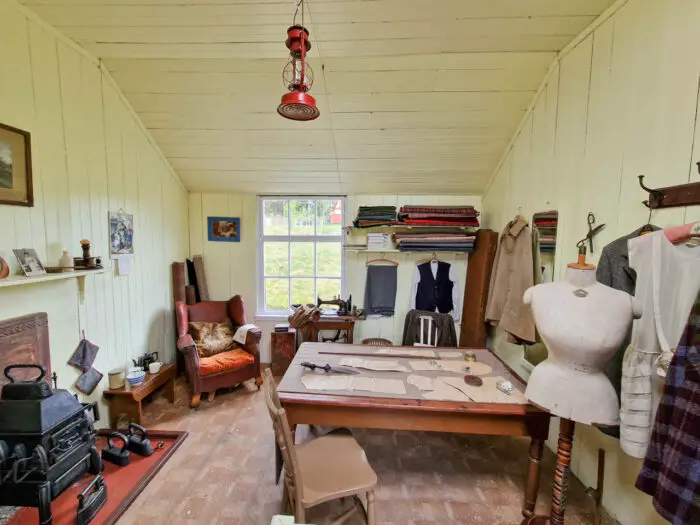I had no idea the Highland Folk Museum even existed before my Highland Fling tour with Haggis Adventures stopped there on the last day of the tour. I’d been to several of the open-air museums in the Nordic and Baltic countries, and love the idea of them. Sadly, half the museum was closed on the day of my visit.

Scotland’s First Open-Air Museum
If you’re not familiar with open-air museums, they’re basically a collection of historic buildings, usually from one region and one period in history. Some of the better museums have multiple regions or historical periods. In the case of the Baltic countries, several different regions of the country over the centuries are represented in the museum. In the case of Scotland’s first open-air museum, the three distinct areas of the museum cover different eras of highland history and architecture.
The Highland Folk Museum was initially started in 1935 as a collection of highland artifacts on the Isle of Iona off the West Coast of Scotland. Over the years, the museum expanded and changed location several times. The current site in Newtonmore, located on the western side of the Cairngorms National Park, opened to the public in 1987. There are three parts of the museum, one representing life in the 1700s, while the other two have buildings and objects from the 19th and 20th centuries.

Shortly before my visit, Storm Arwen, a rare cyclone, damaged many properties across the country, including many castles. The 1700s settlement of the museum was damaged and many of the surrounding trees were torn up. Until they’re restored, it’s just the more modern buildings available to explore.

Life in the Highlands
The Highland Folk Museum has several dozen buildings spread across 80 acres of land. I could have easily spent half the day there studying the different buildings and artifacts, but we only had an hour and a half with the tour and I spent some of that time getting some aerial shots with the drone.
Some of the buildings at the museum were recreated based on old drawings and photographs, while others were relocated from other parts of Scotland to the museum. Some of the buildings throughout the museum are a church, a school, a general store, a farmhouse and barn, a weaver’s house, and a large building full of tools and machinery for woodworking and construction. Often, there are also volunteers dressed for the time period represented in the village, demonstrating different tasks. These are by far my favorite kinds of museums, as rather than reading lots of information, you get to see things in action.
Just for that reason, you really have to experience the Highland Folk Museum for yourself to get the hands-on experience and visuals. But here are a couple of photos from around the museum






Visiting the Highland Folk Museum
The Highland Folk Museum doesn’t have a set entrance fee. Instead, it is run on a donation basis, with all proceeds going toward restorations and expansions. Right now, I can only imagine a lot is going towards reopening the 1700s settlement that was damaged in the storm.
The museum is currently open from April 1 to October 28. Check out their website for exact hours and further information.
It is possible to visit the museum using public transportation from Edinburgh, either by bus or train. But it’s far easier to rent your own car, or enjoy the museum as part of the 5-day Highland Fling tour by Haggis Adventures. If you go by car, consider stopping at the Highland Wildlife Park just a few miles further north, or enjoy some watersports on Loch Morlich.
